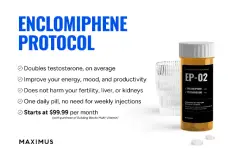You are using an out of date browser. It may not display this or other websites correctly.
You should upgrade or use an alternative browser.
You should upgrade or use an alternative browser.
What causes high hematocrit? High DHT?
- Thread starter MikeXL
- Start date
Nelson Vergel
Founder, ExcelMale.com
Elevated Dihydrotestosterone is Associated with Testosterone-Induced Erythrocytosis
Aghazadeh, Monty et al. The Journal of Urology
Abstract
Introduction Erythrocytosis is the most common dose-limiting adverse effect of testosterone therapy (TTh), but the mechanisms of T-mediated erythropoiesis remain unclear. In this study, we examine risk factors for erythrocytosis associated with TTh. Methods Retrospective review of 179 hypogonadal men on TTh in a single andrology clinic was performed. Demographic data, TTh formulation and duration of treatment, and 5α reductase inhibitor (5ARI) use were assessed. Serum dihydrotestosterone (DHT), total T (TT), free T (FT), follicle stimulating hormone (FSH), luteinizing hormone (LH), Hematocrit (Hct), and lipid levels were extracted and changes during treatment determined. Spearman's rank correlation was used to identify relationships between change in Hct (ΔHct) and study variables. Results Of 179 patients, 49 (27%) developed a ≥10% ΔHct and 36 (20.1%) developed erythrocytosis (Hct ≥50%) at a median follow-up of 7 months. Topical gels were used by 41.3% of patients, injectable T by 52.5%, and subcutaneous pellets by 6.1%. More men who developed ΔHct ≥10% used injectable T than men with ΔHct <10% (65% vs. 48%, p=0.035), and were less likely to be on 5ARI (2% vs. 15%, p=0.017). Men with ΔHct ≥10% had higher post-treatment DHT levels (605.0 vs. 436.0 ng/dL, p=0.017) and lower LH and FSH levels than men with ΔHct <10%. Spearman's rank correlations yielded relationships between ΔHct and post-treatment DHT (ρ=0.258, p=0.001) and TT (ρ=0.171, p=0.023). Conclusion DHT may play a role in TTh-related erythrocytosis, and monitoring of DHT levels during TTh should be considered. In men who develop erythrocytosis, 5ARIs may be therapeutic.
Read more at: https://www.excelmale.com/forum/sho...ia-Caused-by-Testosterone-Replacement-Therapy
Aghazadeh, Monty et al. The Journal of Urology
Abstract
Introduction Erythrocytosis is the most common dose-limiting adverse effect of testosterone therapy (TTh), but the mechanisms of T-mediated erythropoiesis remain unclear. In this study, we examine risk factors for erythrocytosis associated with TTh. Methods Retrospective review of 179 hypogonadal men on TTh in a single andrology clinic was performed. Demographic data, TTh formulation and duration of treatment, and 5α reductase inhibitor (5ARI) use were assessed. Serum dihydrotestosterone (DHT), total T (TT), free T (FT), follicle stimulating hormone (FSH), luteinizing hormone (LH), Hematocrit (Hct), and lipid levels were extracted and changes during treatment determined. Spearman's rank correlation was used to identify relationships between change in Hct (ΔHct) and study variables. Results Of 179 patients, 49 (27%) developed a ≥10% ΔHct and 36 (20.1%) developed erythrocytosis (Hct ≥50%) at a median follow-up of 7 months. Topical gels were used by 41.3% of patients, injectable T by 52.5%, and subcutaneous pellets by 6.1%. More men who developed ΔHct ≥10% used injectable T than men with ΔHct <10% (65% vs. 48%, p=0.035), and were less likely to be on 5ARI (2% vs. 15%, p=0.017). Men with ΔHct ≥10% had higher post-treatment DHT levels (605.0 vs. 436.0 ng/dL, p=0.017) and lower LH and FSH levels than men with ΔHct <10%. Spearman's rank correlations yielded relationships between ΔHct and post-treatment DHT (ρ=0.258, p=0.001) and TT (ρ=0.171, p=0.023). Conclusion DHT may play a role in TTh-related erythrocytosis, and monitoring of DHT levels during TTh should be considered. In men who develop erythrocytosis, 5ARIs may be therapeutic.
Read more at: https://www.excelmale.com/forum/sho...ia-Caused-by-Testosterone-Replacement-Therapy
Nelson Vergel
Founder, ExcelMale.com
In this nationally representative study of men, sex steroid hormone levels, particularly low free testosterone and high SHBG levels, were associated with lower hematocrit, and high total and free estradiol levels were associated with high hematocrit.
http://www.ncbi.nlm.nih.gov/pmc/articles/PMC3774012/
http://www.ncbi.nlm.nih.gov/pmc/articles/PMC3774012/
Similar threads
- Replies
- 3
- Views
- 3K
- Replies
- 30
- Views
- 13K
- Replies
- 19
- Views
- 1K
- Replies
- 5
- Views
- 746
Online statistics
- Members online
- 0
- Guests online
- 185
- Total visitors
- 185
Totals may include hidden visitors.














